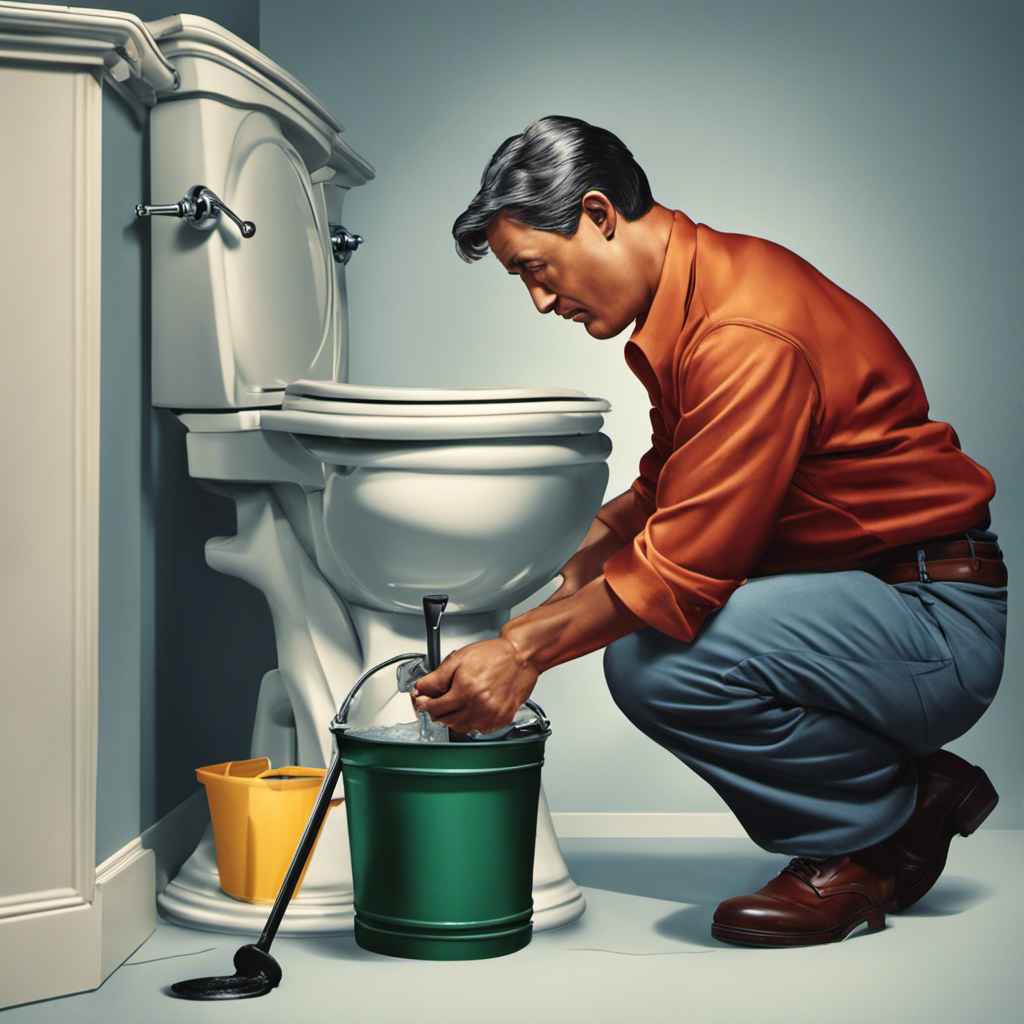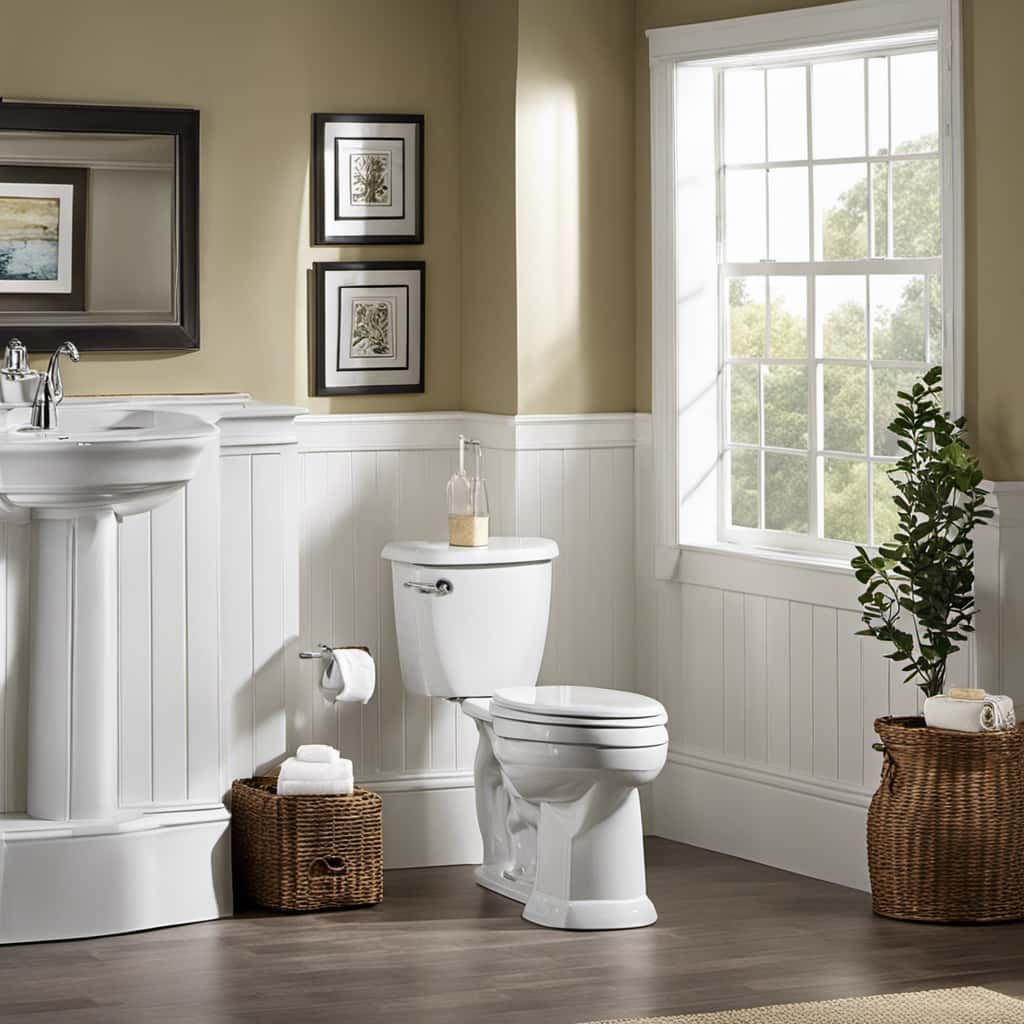Did you know that a low water level in your toilet can lead to poor flushing and other plumbing issues?
In this article, I will guide you through the steps to raise the water level in your toilet, ensuring optimal performance.
First, we will assess the current water level, then make necessary adjustments to the float or fill valve.
We will also check for any clogs or blockages and explore ways to increase water flow from the supply line.
If you’re ready to tackle this DIY project, let’s get started!
Key Takeaways
- Low water level in the toilet tank can lead to poor flushing and plumbing issues.
- The water level in the toilet tank can be assessed by measuring water consumption during a flush and marking the water level before flushing.
- Adjusting the float or fill valve can regulate the amount of water in the tank.
- Checking for clogs or blockages in the toilet bowl and drain pipe, and increasing water flow from the supply line can help improve water level in the toilet.
Assessing the Current Water Level
You need to first check if the water level in your toilet is too low or too high.
To do this, I recommend measuring the water consumption during a flush. Start by marking the water level in the toilet tank with a pencil or tape.
Then, flush the toilet and observe the water level after the flush. If the water level is too low, it may indicate a problem with the flushing mechanism, such as a faulty flapper or a clogged drain line.
If the water level is too high, it could mean a problem with the fill valve or an issue with the float.
Troubleshooting the flushing mechanism will help you identify the cause of the water level issue and take appropriate steps to raise it to the desired level.
Adjusting the Float or Fill Valve
Simply adjust the float or fill valve to regulate the amount of water in the tank. This is a simple and effective solution to raise the water level in a toilet. However, there are some common problems that may arise when adjusting these valves. Here are some troubleshooting tips to help you overcome these issues:
-
The float is not rising properly:
-
Check for any obstructions or debris that may be preventing the float from moving freely.
-
Ensure that the float arm is properly attached to the fill valve.
-
The fill valve is not shutting off:
-
Check if the water level is set too high, causing the fill valve to continuously run.
-
Inspect the fill valve for any signs of damage or wear.
-
The water level drops after adjusting:
-
Verify that the fill valve is securely tightened to prevent any leaks.
-
Check if there are any cracks or leaks in the tank that may be causing the water level to decrease.
Checking for Clogs or Blockages
Checking for clogs or blockages is an important step in troubleshooting common toilet issues. When faced with a toilet that won’t flush properly or is slow to drain, it’s crucial to identify potential obstructions that might be causing the problem.
Start by visually inspecting the toilet bowl and drain pipe for any visible blockages, such as toilet paper or foreign objects. If nothing is apparent, you can use a plunger to try and dislodge any potential clogs.
For more stubborn drainage issues, a toilet auger can be used to clear the blockage by physically breaking it up.
Once you have checked for clogs and blockages, you can move on to increasing water flow from the supply line, allowing for better flushing and drainage.
Increasing Water Flow From the Supply Line
To improve the flow of water from the supply line, try adjusting the valve to allow for more water to enter the toilet tank. This will help increase the water level in the tank, ultimately improving the water pressure when you flush the toilet.
When troubleshooting the water supply, consider the following:
- Check for any obstructions or blockages in the supply line that may be restricting water flow.
- Ensure that the shut-off valve is fully open to allow for maximum water flow.
- If the water pressure is still low, you may need to clean or replace the fill valve to ensure proper functioning.
Consulting a Professional Plumber
If you’re experiencing persistent issues with your plumbing, it may be time to consult a professional plumber for expert advice and assistance. While DIY toilet repairs can be beneficial in some cases, there are common toilet water level issues that may require the expertise of a professional. Here is a table that highlights these issues:
| Common Toilet Water Level Issues |
|---|
| Low water level in the bowl |
| Constantly running toilet |
| Inconsistent water level |
A professional plumber has the knowledge and experience to accurately diagnose and fix these issues. They can identify the underlying cause, whether it’s a problem with the fill valve, flapper, or other components, and provide the appropriate solution. Additionally, hiring a professional ensures that the repairs are done correctly and efficiently, saving you time and frustration. So, if you’re experiencing persistent toilet water level issues, it’s wise to consult a professional plumber for the best possible outcome.
Frequently Asked Questions
Can I Use Any Household Items to Increase the Water Level in the Toilet?
Yes, I can use household items to increase the water level in the toilet. There are various methods, such as using a plastic bottle or adjusting the float valve. These simple solutions can help raise the water level efficiently.
What Should I Do if the Float or Fill Valve Is Not Adjustable?
If the float or fill valve is not adjustable, there are alternative solutions to raise the water level in the toilet. Non-adjustable valve options include installing a water-saving device or contacting a professional plumber for assistance.
How Do I Know if There Is a Clog or Blockage in the Toilet?
To determine if there’s a clog or blockage in the toilet, I would check for signs like slow draining or water backing up. If necessary, I can use techniques like plunging or using a toilet auger to fix the issue.
Is It Safe to Increase Water Flow From the Supply Line Myself?
Increasing water pressure by adjusting the water level in the toilet can be done safely by following the proper steps. It is important to have a basic understanding of plumbing and to exercise caution when making any adjustments.
How Much Does It Typically Cost to Consult a Professional Plumber for This Issue?
Consulting a professional plumber for the issue of raising water level in a toilet can be costly. However, there are alternative methods available that can save you money. Let’s explore these options further.
Conclusion
In conclusion, you can successfully raise the water level in your toilet by following the steps outlined in this article.
While some may argue that hiring a professional plumber is the best solution, it is important to note that with the right knowledge and tools, this task can be easily accomplished on your own.
By assessing the water level, adjusting the float or fill valve, checking for clogs, and increasing water flow from the supply line, you can ensure a properly functioning toilet without the need for outside assistance.










